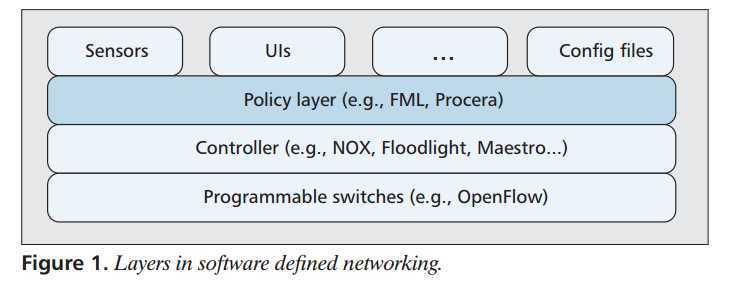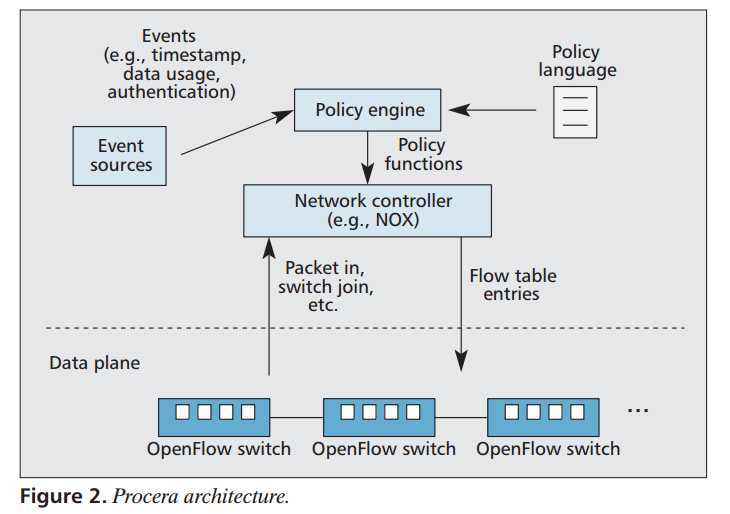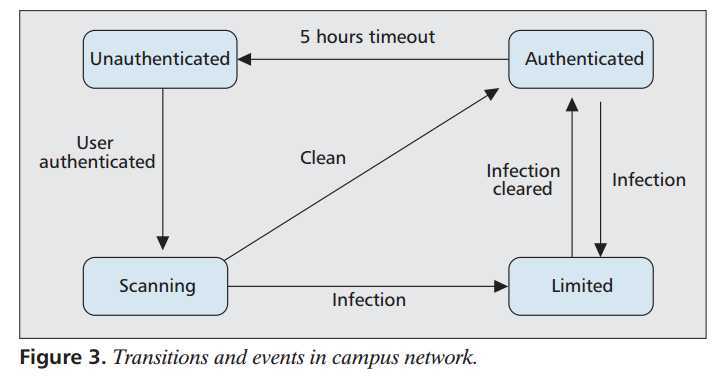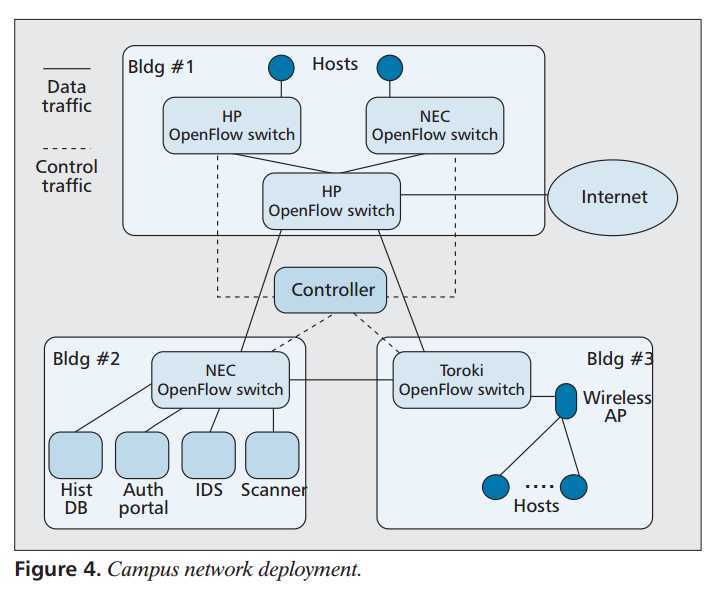标签:框架 aging 相对 方法 scan OWIN most translate raise
Network management is challenging. To operate, maintain, and secure a communication network, network operators must grapple(扭打、打交道) with low-level vendor-specific configuration to implement complex high-level network policies. Despite many previous(先前的) proposals(建议) to make networks easier to manage, many solutions to network management problems amount to stop-gap(权宜之计) solutions because of the difficulty of changing the underlying infrastructure. The rigidity(僵硬) of the underlying infrastructure presents few possibilities for innovation or improvement, since network devices have generally been closed, proprietary, and vertically integrated. A new paradigm(范式) in networking, software defined networking (SDN), advocates separating the data plane and the control plane, making network switches in the data plane simple packet forwarding devices and leaving a logically centralized software program to control the behavior of the entire network. SDN introduces new possibilities for network management and configuration methods. In this article, we identify problems with the current state-of-the-art(最先进的) network configuration and management mechanisms and introduce mechanisms to improve various aspects of network management. We focus on three problems in network management: enabling frequent changes to network conditions and state, providing support for network configuration in a highlevel language, and providing better visibility and control over tasks for performing network diagnosis(诊断) and troubleshooting(排除). The technologies we describe enable network operators to implement a wide range of network policies in a high-level policy language and easily determine sources of performance problems. In addition to the systems themselves, we describe various prototype deployments in campus and home networks that demonstrate how SDN can improve common network management tasks.
operate, maintain, and secure a communication network 为了操作、维护和保护通信网络,网络运营商必须与特定于供应商的低级配置打交道,以实现复杂的高级网络策略。
closed, proprietary, and vertically integrated 由于网络设备通常是封闭的、专有的和垂直集成的,因此底层基础设施造成网络僵化,几乎没有创新或改进的可能性。
一种新的网络模式,软件定义的网络(SDN)主张分离数据平面和控制平面,使数据平面上的网络交换机成为简单的包转发设备,并留下一个逻辑集中的软件程序来控制整个网络的行为
network management and configuration methods SDN为网络管理和配置方法带来了新的可能性
我们关注网络管理中的三个问题:
network conditions and state 使网络条件和状态能够频繁更改
highlevel language 用高级语言支持网络配置
better visibility and control 为执行网络诊断和故障排除提供更好的可见性和对任务的控制
Computer networks are dynamic and complex; unsurprisingly, as a result, configuring and managing them continues to be challenging. These networks typically comprise a large number of switches, routers, firewalls, and numerous types of middleboxes with many types of events occurring simultaneously. Network operators are responsible for configuring the network to enforce various high-level policies, and to respond to the wide range of network events (e.g., traffic shifts, intrusions) that may occur. Network configuration remains incredibly difficult because implementing these high-level policies requires specifying them in terms of distributed low-level configuration. Today’s networks provide little or no mechanism for automatically responding to the wide range of events that may occur
Today, network operators must implement increasingly sophisticated(先进的) policies and complex tasks with a limited and highly constrained set of low-level device configuration commands in a command line interface (CLI) environment. Not only are network policies low-level, they are also not well equipped to react to continually changing network conditions. State-of-the-art network configuration methods can implement a network policy that deals with a single snapshot(快照、简介) of the network state. However, network state changes continually, and operators must manually(手动地) adjust network configuration in response to changing network conditions. Due to this limitation, operators use external tools, or even build ad hoc scripts(构建临时脚本) to dynamically reconfigure network devices when events occur. As a result, configuration changes are frequent and unwieldy(笨拙), leading to frequent misconfigurations
Network operators need better ways to configure and manage their networks. Unfortunately, today’s networks typically(典型地) involve integration(整合) and interconnection of many proprietary(专有的), vertically integrated devices. This vertical integration makes it incredibly difficult for operators to specify high-level network-wide policies using current technologies. Innovation in network management has thus been limited to stop-gap techniques and measures, such as tools that analyze low-level configuration to detect errors or otherwise respond to network events. Proprietary software and closed development in network devices by a handful of vendors make it extremely difficult to introduce and deploy new protocols. Incremental(增量) “updates” to configuration methods and commands are generally dictated(支配) unilaterally(单方面的) by vendors(供应商). Meanwhile, operators’ requirements for more functionality and increasingly complex network policies continue to expand.
Software defined networking (SDN) is a paradigm where a central software program, called a controller, dictates the overall network behavior. In SDN, network devices become simple packet forwarding devices (data plane), while the “brain” or control logic is implemented in the controller (control plane). This paradigm shift brings several benefits compared to legacy methods. First, it is much easier to introduce new ideas in the network through a software program, as it is easier to change and manipulate(操作) than using a fixed(固定的) set of commands in proprietary network devices. Second, SDN introduces the benefits of a centralized approach to network configuration, opposed(而不是) to distributed management: operators do not have to configure all network devices individually to make changes in network behavior, but instead make networkwide traffic forwarding decisions in a logically single location, the controller, with global knowledge of the network state.
In this article, we explore how SDN can provide better mechanisms for common(共同的) network management and configuration tasks across a variety of different types of networks. While many prior studies have explored the potential benefits of applying SDN in computer networks to facilitate the evolution of network technologies(e.g., RCP [5], 4D [6], and Ethane [2]), there has been little study of how SDN might make various tasks associated with managing and operating a network easier
To allow operators to express and implement reactive high-level policies in an easier manner, we have designed and implemented Procera, an event-driven network control framework based on SDN paradigm. Our policy language and accompanying control framework, Procera, is based on functional reactive programming (FRP). Procera allows operators to express highlevel policies with this language, and translates such polices into a set of forwarding rules, which are used to enforce the policy on the underlying network infrastructure, using OpenFlow [10]. We have used Procerato reimplement(重新配置) the existing network policy in the Georgia Tech campus network, which uses complicated(复杂的) VLAN technology and many middleboxes to enforce the campus policy. In combination with the BISmark suite [11], we have implemented a home network management system as well, which does not exist or extremely hard to implement with state-of-the-art(最先进的) legacy configuration methods. Our deployment demonstrates that Procera and SDN can greatly reduce the workload of network configuration and management, and introduce additional functionalities to the network easily
dynamic and complex 计算机网络是动态的和复杂的,因此配置和管理它们仍然是一项挑战。
events occurring simultaneously 这些网络通常由大量交换机、路由器、防火墙和多种类型的中间盒组成,其中许多类型的事件同时发生
distributed low-level configuration 网络配置仍然非常困难,因为实现高级策略需要用分布式低级配置来指定
limited and highly constrained 如今,网络运营商必须在命令行界面(CLI)环境中使用一组有限且高度受限的低级设备配置命令来实现越来越复杂的策略和任务
continually changing network conditions 不仅网络策略低级,而且也没有很好的设备来应对不断变化的网络条件
manually adjust network configuration 面对网络状态不断变化,运营商必须根据不断变化的网络条件手动调整网络配置
frequent and unwieldy 配置更改频繁且笨拙,导致频繁的错误配置
specify high-level network-wide policies 垂直整合使得运营商难以使用当前技术指定高级别的网络范围策略
brings several benefits 与传统方法相比,SDN带来了一些好处:
- change and manipulate 通过软件程序在网络中引入新思想要容易得多,因为与在专有网络设备中使用固定的命令集相比,它更容易更改和操作
- centralized approach SDN引入了集中式网络配置方法的优点,不必单独配置所有网络设备来更改网络行为
common network management and configuration tasks 在本文中,我们将探讨SDN如何为跨各种不同类型的网络的公共网络管理和配置任务提供更好的机制
an event-driven network control framework 为了使运营商能够以更简单的方式表达和实现反应性高级策略,我们设计并实现了基于SDN范式的事件驱动网络控制框架Procera
Procera允许运营商用这种语言表达高级策略,并将这些策略转换为一组转发规则,这些规则使用OpenFlow在底层网络基础设施上实施策略。
Software defined networking has roots in previous network control systems such as RCP [5], 4D [6], and Ethane [2]. Recent work has introduced the notion(概念) of southbound and northbound interfaces. The southbound interface refers to the interface and protocol between programmable switches (SDN-capable switches) and the software controller. The northbound interface determines how to express operational tasks and network policies, and also how to translate them into a form the controller can understand.
In Fig. 1, the protocol between the controller and programmable switch layer is referred to as southbound;

northbound refers to the upper part of the controller, including the policy layer. OpenFlow [10] is one of the most common southbound SDN interfaces. Many vendors, including HP, NEC, NetGear, and IBM, produce OpenFlow-capable network switches available in the market. The Open Networking Foundation (ONF) is responsible for standardizing the OpenFlow protocol. There are a variety of OpenFlow controllers, for example, NOX [7], Floodlight, and Maestro [1]. NOX is a framework that allows developers to program their software program with C++ or Python, using a set of application programming interfaces (APIs) to interact with OpenFlow-capable switches, while Floodlight is a Java-based controller. Maestro focuses on achieving better performance and scalability in a centralized controller using multithreading.
Although there has been much study and industrial effort in defining, polishing, and implementing the southbound part of SDN protocols, there has been relatively little attention on northbound interfaces and protocols. Procera is one effort to define a northbound interface that provides the ability to specify and implement reactive policies.
previous network control systems 软件定义的网络起源于以前的网络控制系统
southbound interface 南向接口是指可编程交换机(支持SDN的交换机)与软件控制器之间的接口和协议
northbound interface 北向接口决定了如何表达操作任务和网络策略,以及如何将它们转换成控制器可以理解的形式
尽管在定义、完善和实现SDN协议的南向部分方面已经有了大量的研究和工业努力,但对北向接口和协议的关注相对较少。
provides the ability to specify and implement reactive policies Procera致力于定义一个北向接口,该接口提供指定和实现响应策略的能力
Procera is a network control framework that helps operators express event-driven network policies that react to various types of events using a high-level functional programming language. Procera effectively serves as a glue between high-level event-driven network policies and low-level network configuration. To express event-driven network policies, Procera offers a set of control domains that operators can use to set certain conditions and assign appropriate packet forwarding actions corresponding to each condition. Additional control domains can help operators implement flexible, reactive network policies. Operators can also combine control domains to implement rich network policies, instead of relying on time or event-triggered scripts, which are error-prone.
The set of control domains Procera supports are summarized in Table 1

We do not claim that the current set of control domains is complete, but it is sufficient to support a range of network policies in different types of network environments that are difficult to implement in conventional configuration languages
Figure 2 shows the Procera architecture. We elaborate(详细说明) on each component in the following subsections

Event sources are network components or middleboxes that can send dynamic events to the Procera controller. Intrusion detection systems, network bandwidth monitoring systems, and authentication systems are good examples of event sources. Simple Network Management Protocol (SNMP) or even values in /proc can be good event sources as well. As long as there is a parser in the policy engine component that understands such events, any kind of event can be raised. We do not define a fixed interface protocol between event sources and the policy engine, and there can be various alternative methods, such as JSON-RPC. Currently, as a proof of concept, event sources in our deployment periodically send files that contain relevant information, such as the bandwidth usage of every end-host device, along with timestamps.
The policy engine component is responsible for parsing the network policy expressed with a policy language, and also processing various events that come from event sources. Based on the given policy language and asynchronous events, the policy engine refreshes its policy state, which defines the network policy to be enforced, and sends the policy functions to the network controller when the policy state changes. Some reactive policies change the policy state simply according to changes in the time of day, without any external event; the policy language supports these types of reactive changes. The Procera policy language is based on functional reactive programming (FRP). It allows operators to specify complex and reactive network policies in a simple and declarative language. The policy is an embedded domain-specific language in Haskell. Due to scope and page limitations, we do not include details on our policy language in this article; more details are in a work paper on Procera
Procera follows the software defined networking paradigm, and thus has a controller that makes all traffic forwarding decisions and updates lowlevel network switch flow-table entries according to this policy. The network controller translates the network policy to actual packet forwarding rules. The network controller establishes a connection to each OpenFlow-capable switch through the OpenFlow protocol [10], and inserts, deletes, or modifies packet forwarding rules in switches through this connection. The network controller also reacts to packet-in events and switch-join events that come from switches. For packet-in events, the network controller will install relevant forwarding rules in the switch, and for switch-join events, it will establish a new connection with that specific switch. Currently, Procera uses OpenFlow specification version 1.0.0.
event-driven network policies Procera是一个网络控制框架,它帮助运营商表达事件驱动的网络策略
high-level functional programming language 这些策略使用高级函数式编程语言,对各种类型的事件作出反应
a set of control domains Procera提供了一组控制域,操作员可以使用这些域来设置特定条件,并根据每个条件分配适当的包转发操作
一组控制域:
- Time 网络运营商通常需要实施网络行为取决于一天中的日期或时间的策略
- Data usage 运营商有时会指定策略,根据该策略,网络的行为取决于特定时间间隔内的数据使用量(下载/上载)或数据传输速率
- Status 操作员可能希望为不同的用户或用户组指定权限
- Flow 网络运营商希望根据数据包或流中指定的多层中的不同字段值指定不同的网络行为
EVENT SOURCES 事件源是可以向PROCER控制器发送动态事件的网络组件或中间包
POLICY ENGINE AND LANGUAGE 策略引擎组件负责解析用策略语言表示的网络策略,并处理来自事件源的各种事件
NETWORK CONTROLLER Procera遵循软件定义的网络模式,因此有一个控制器,根据该策略做出所有流量转发决策并更新低级网络交换机流表条目
We describe the deployment of Procera in a campus network. Campus networks are dynamic environments with many events occurring across the network. Network policies for campus and enterprise networks are very complex and thus error-prone, which makes them a good subject for deploying Procera.
The Georgia Tech campus network requires every unregistered end-host device to undergo an authentication process via an authentication web portal. After successful authentication with a username and password, the device is scanned for possible vulnerabilities. If none are found, the device is finally granted access to the internal network and the Internet. This simplified version of the actual network policy still involves a complex mechanism that requires input from multiple external tools. In particular, the Georgia Tech campus network relies on virtual LAN (VLAN) technology, where unregistered and registered devices are separated by different VLAN domains. Based on the authentication and scanning results, devices are moved back and forth from two different VLAN domains, and network switches deployed in the network have to constantly download the up-to-date VLAN map from the central VLAN management server (VMPS) to perform correct forwarding behavior
Implementing such complex and reactive network policy with static tools like firewall rules and VLAN technology requires network operators to independently configure multiple different components, including middleboxes, management servers, and numerous ad hoc scripts. Procera significantly simplifies the expression of these types of policies
Figure 3 shows the Georgia Tech campus network policy in terms of a state machine model.

The policy can be expressed elegantly with events and transitions among different states. User devices in unauthenticated state cannot access the network. Successful authentication with credentials (username and password) moves a device to scanning state, where only traffic between the vulnerability scanner is allowed. After no known vulnerabilities are found, a device can transition to the authentication state where the device is finally granted full access to the network. Any infection event from an intrusion detection system can move the device state to limited, where access to the network and Internet access are blocked. After five hours of inactivity, the user is required to authenticate again.
Our campus deployment spans three buildings in the Georgia Tech campus, as shown in Fig. 4.

For packet forwarding, we use five OpenFlowcapable network switches from HP, NEC, and Toroki. There are two wireless access points deployed in building 3, through which end-host devices can connect to through a broadcasted SSID. The authentication web portal, intrusion detection system, and scanner, which are event sources, are located in the data closet in building 2.
dynamic environments 校园网是一个动态的环境,网络上发生着许多事件,网络策略非常复杂且容易出错
乔治亚理工大学校园网要求每个未注册的终端主机设备通过认证门户进行认证过程。使用用户名和密码成功进行身份验证后,将扫描设备是否存在可能的漏洞。如果没有找到,设备最终被授予访问内部网络和Internet的权限。
requires input from multiple external tools 实际网络策略的这个简化版本仍然包含一个复杂的机制,需要来自多个外部工具的输入,而Procera大大简化了这些类型策略的表达
We describe the deployment of Procera in home networks, and how Procera makes it easier to express various types of policies
One of the problems about home networks is that they offer only limited visibility into home broadband performance and its overall status. Measurements performed by individual users with browser-based tools like speedtest.net provide limited one-time measurement results,which are likely influenced by many different factors, such as browser type or host computer condition. Access Internet service providers (ISPs) often want to continuously monitor the status of home networks, and ensure that customers receive their promised service. Content providers may desire to know how their traffic engineering decisions influence the home user experience. BISmark is a collection of home gateways installed in households, a centralized management and data collection server, and multiple measurement servers deployed around the world. The home gateway performs various types of active and passive measurements, which are collected in the centralized management and data collection server for further analysis. As of November 2012, there were around 270 active BISmark gateways deployed around the world. Periodic active and passive measurement results can be used to validate (or invalidate) certain expectations of home networks, and also reveal interesting findings in our Internet [11].
limited visibility 家庭网络的一个问题是,它们只能提供有限的家庭宽带性能及其整体状况的可见性。
BISmark 这是一种安装在家庭中的家庭网关、集中管理和数据收集服务器以及部署在世界各地的多个测量服务器的集合
various types of active and passive measurements 家庭网关执行各种类型的主动和被动测量,这些测量被收集在集中管理和数据收集服务器中以供进一步分析
Improving Network Management with Software Defined Networking
标签:框架 aging 相对 方法 scan OWIN most translate raise
原文地址:https://www.cnblogs.com/chelinger/p/11559740.html